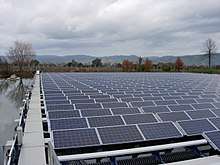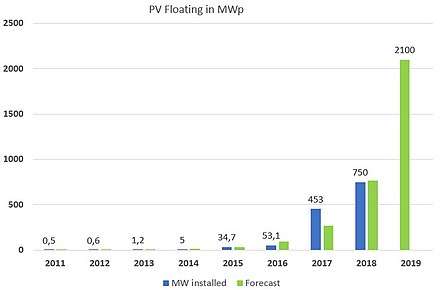Floating solar
Floating solar refers to a solar power production installation mounted on a structure that floats on a body of water, typically an artificial basin or a lake.
Two types of systems can be distinguished: FPV or Floating photovoltaic, that uses photovoltaic panels mounted on the platform, and floating Concentrated solar power, that uses mirrors that redirect the solar power to a tower.
FPV

This technology has had a rapid growth on the renewable energy market since 2016. The first 20 plants, of a few dozen of kWp have been built between 2008 and 2014 as reported in the MIRARCO paper [1] that analyzed the birth of this technology.
The installed power reached 1.1 GW in 2018.[2][3] The costs for a floating system are 20-25% higher than for ground-mounted systems.[4]
Technology features
There are several reasons for this development:
- No land occupancy: the main advantage of floating PV plants is that they do not take up any land, except the limited surfaces necessary for electric cabinet and grid connections. Their price is comparable with land based plants, but they provide a good way to avoid land consumption.[5]
- Installation and decommissioning: floating PV plants are more compact than land-based plants, their management is simpler and their construction and decommissioning straightforward. The main point is that no fixed structures exist like the foundations used for a land-based plant so their installation can be totally reversible.
- Water saving and water quality: the partial coverage of basins can reduce the water evaporation. This result depends on climate conditions and on the percentage of the covered surface. In arid climates such as Australia this is an important advantage since about 80% of the evaporation of the covered surface is saved and this means more than 20,000 m3/year/ha. This is a very useful feature if the basin is used for irrigation purposes.[6][7]
- Cooling: the floating structure allows the implementation of a simple cooling system. Cooling mechanism is natural but can also be active by generating a water layer on the PV modules or using a submerged PV modules, the so-called SP2 (Submerged Photovoltaic Solar Panel).[8] In these cases the global PV modules efficiency rises thanks to the absence of thermal drift, with a gain in energy harvesting up to 8-10%.
- Tracking: a large floating platform can be easily turned and can perform a vertical axis tracking: this can be done without wasting energy and without the need for a complex mechanical apparatus as in land-based PV plants. A floating PV plant equipped with a tracking system has a limited additional cost while the energy gain can range from 15 to 25%.[9]
- Storage opportunity: the presence of water naturally suggests using gravity energy storage mainly in the coupling with hydroelectric basins. However other possibilities has been explored and in particular CAES systems have been suggested.[10]
- Environment control: a parallel advantage is the containment of the algae bloom, a serious problem in industrialized countries. The partial coverage of the basins and the reduction of light on biological fouling just below the surface, together with active systems can solve this problem. This is only a part of the more general problem of managing a water basin generated by industrial activities or polluted by them. See for example the mining managing.[11]
- Efficiency improvement: Many studies claim that there is a significant improvement in efficiency putting solar panels over water. These studies are not conclusive and differ in their conclusion. The energy gain reported range from 5 to 15%.[12][13][14]
History
American, Danish, French, Italian and Japanese nationals were the first to register patents for floating solar. In Italy the first registered patent, regarding PV modules on water, goes back to February 2008.[15]
The MIRARCO (Mining Innovation Rehabilitation and Applied Research Corporation Ontario, CANADA) research group quotes several solutions that were put forward in the years 2008-2011 and 2012-2014.[1] Without being exhaustive the installations can be classified into three categories:
- PV plants constituted by modules mounted on pontoons
- PV modules mounted on rafts built in plastic and galvanized steel
- PV modules mounted on rafts, fully in plastic.
It is Impossible to give a detailed analysis of the many small PV floating plants built in the first 10 years. The plot here below is based on data taken from the web for FPV with more than 500 kW of power. In the Asian Clean Energy Summit in Singapore (Oct. 2017) two numbers where quoted by the World- Bank Group: 453 MWp for installation in 2017 and a forecast of 750 MWp for 2018.
The following graph shows the growth of solar floating installations globally from the beginning.

Data taken from "Where Sun Meets Water: Floating Solar Market Report," World Bank Group and SERIS, Singapore, 2018.
Floating CSP
Floating CSP has similar advantages to floating photovoltaics.[16][17]
References
- K. Trapani and M. R. Santafe (2014). "A review of floating photovoltaic installations 2007–2013". Prog. Photovolt: Res. Appl.
- World Bank Group, ESMAP, and SERIS. 2018. Where Sun Meets Water: Floating Solar Market Report - Executive Summary. Washington, DC: World Bank.
- Kenning, Tom (2018-11-01). "Floating solar surpasses 1GW globally - World Bank". PV Tech.
- Martín, José Rojo (2019-10-27). "BayWa r.e. adds to European floating solar momentum with double project completion". PV Tech.
- R. Cazzaniga, M. Rosa-Clot, P. Rosa-Clot and G. M. Tina (2018). "Geographic and Technical Floating Photovoltaic Potential". Thermal Energy Science.CS1 maint: multiple names: authors list (link)
- Taboada, M.E.; Cáceres, L.; Graber, T.A.; Galleguillos, H.R.; Cabeza, L.F.; Rojas, R. (2017). "Solar water heating system and photovoltaic floating cover to reduce evaporation: Experimental results and modeling". Renewable Energy. 105: 601–615. doi:10.1016/j.renene.2016.12.094. hdl:10459.1/59048. ISSN 0960-1481.
- Hassan, M.M. and Peyrson W.L. (2016). "Evaporation mitigation by floating modular devices". Earth and Environmental Science. 35.
- Choi, Y.K. (2014). "A study on power generation analysis on floating PV system considering environmental impact". Int. Jour. Of Sw Engineering and Appl. 8: 75–84.
- R. Cazzaniga, M. Cicu, M. Rosa-Clot, P. Rosa-Clot, G. M. Tina and C. Ventura (2018). "Floating photovoltaic plants: performance analysis and design solutions". Renewable and Sustainable Reviews. 81: 1730–1741. doi:10.1016/j.rser.2017.05.269.CS1 maint: multiple names: authors list (link)
- R. Cazzaniga, M. Cicu, M. Rosa-Clot, P. Rosa-Clot, G. M. Tina and C. Ventura (2017). "Compressed air energy storage integrated with floating photovoltaic plant". Journal of Energy Storage. 13: 48–57. doi:10.1016/j.est.2017.06.006.CS1 maint: multiple names: authors list (link)
- Trapani, K. and Millar, B. (2016). "Floating photovoltaic arrays to power mining industry: a case study for the McFaulds lake (ring of fire)". Sustainable Energy. 35: 898–905.CS1 maint: multiple names: authors list (link)
- Choi, Y.-K. and N.-H. Lee (2013). "Empirical Research on the efficiency of Floating PV systems compared with Overland PV Systems". Conference Proceedings of CES-CUBE.
- "Floating Solar On Pumped Hydro, Part 1: Evaporation Management Is A Bonus". CleanTechnica. 27 December 2019.
- "Floating Solar On Pumped Hydro, Part 2: Better Efficiency, But More Challenging Engineering". CleanTechnica. 27 December 2019.
- M. Rosa-Clot and P. Rosa-Clot (2008). "Support and method for increasing the efficiency of solar cells by immersion". Italy Patent PI2008A000088.
- Heliofloat: specifics
- Floating CSP in India
Bibliography
- Condie, Scott A.; Webster, Ian T. (1997). "The influence of wind stress, temperature, and humidity gradients on evaporation from reservoirs". Water Resources Research. 33 (12): 2813. Bibcode:1997WRR....33.2813C. doi:10.1029/97WR02405.
- Howard, E. and Schmidt, E. 2008. Evaporation control using Rio Tinto's Floating Modules on Northparks Mine, Landloch and NCEA. National Centre for Engineering in Agriculture Publication 1001858/1, USQ, Toowoomba.
- McJannet, D.L., Webster, I.T., Stenson, M. and Sherman, B., 2008. A method to estimate open water evaporation losses across the Murray Darling Basin. CSIRO Report.
- R. Cazzaniga, M. Cicu, M. Rosa-Clot, P. Rosa-Clot, G. M. Tina and C. Ventura (2017). "Floating Photovoltaic plants: performance analysis and design solutions". Renewable and Sustainable Energy Reviews. 81: 1730–1741. doi:10.1016/j.rser.2017.05.269.CS1 maint: multiple names: authors list (link)
- Sallam, Gehan A.H.; Elsayed, E.A. (2015). "Estimating relations between temperature, relative humidity as independed variables and selected water quality parameters in Lake Manzala, Egypt". Ain Shams Engineering Journal. 9: 1–14. doi:10.1016/j.asej.2015.10.002.
- Taboada, M.E.; Cáceres, L.; Graber, T.A.; Galleguillos, H.R.; Cabeza, L.F.; Rojas, R. (2017). "Solar water heating system and photovoltaic floating cover to reduce evaporation: Experimental results and modeling". Renewable Energy. 105: 601–615. doi:10.1016/j.renene.2016.12.094. hdl:10459.1/59048.
- Chang, Yuan-Hsiou; Ku, Chen-Ruei; Yeh, Naichia (2014). "Solar powered artificial floating island for landscape ecology and water quality improvement". Ecological Engineering. 69: 8–16. doi:10.1016/j.ecoleng.2014.03.015.
- Cazzaniga, R.; Rosa-Clot, Marco; Rosa-Clot, Paolo; Tina, Giuseppe M. (2012). "Floating tracking cooling concentrating (FTCC) systems". 2012 38th IEEE Photovoltaic Specialists Conference. pp. 000514–000519. doi:10.1109/PVSC.2012.6317668. ISBN 978-1-4673-0066-7.
- Ho, C.J.; Chou, Wei-Len; Lai, Chi-Ming (2016). "Thermal and electrical performances of a water-surface floating PV integrated with double water-saturated MEPCM layers". Applied Thermal Engineering. 94: 122–132. doi:10.1016/j.applthermaleng.2015.10.097.
- Lu, Hsiao-Ling; Ku, Chen-Ruei; Chang, Yuan-Hsiou (2015). "Water quality improvement with artificial floating islands". Ecological Engineering. 74: 371–375. doi:10.1016/j.ecoleng.2014.11.013.
- M. Rosa-Clot, G. M. Tina (2017). Submerged and Floating Photovoltaic Systems Modelling, Design and Case Studies. Academic Press.
- Sahu, Alok; Yadav, Neha; Sudhakar, K. (2016). "Floating photovoltaic power plant: A review". Renewable and Sustainable Energy Reviews. 66: 815–824. doi:10.1016/j.rser.2016.08.051.
- Trapani, Kim; Millar, Dean L. (2013). "Proposing offshore photovoltaic (PV) technology to the energy mix of the Maltese islands". Energy Conversion and Management. 67: 18–26. doi:10.1016/j.enconman.2012.10.022.
- Siecker, J.; Kusakana, K.; Numbi, B.P. (2017). "A review of solar photovoltaic systems cooling technologies". Renewable and Sustainable Energy Reviews. 79: 192–203. doi:10.1016/j.rser.2017.05.053.